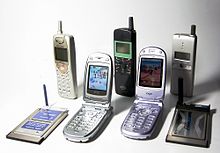The first commercially automated cellular network (the 1G generation) was launched in Japan by NTT in 1979. The initial launch network covered the full metropolitan area of Tokyo's over 20 million inhabitants with a cellular network of 23 base stations. Within five years, the NTT network had been expanded to cover the whole population of Japan and became the first nation-wide 1G network.
The second launch of 1G networks was the simultaneous launch of the Nordic Mobile Telephone (NMT) system in Denmark, Finland, Norway and Sweden in 1981.[12]. NMT was the first mobile phone network featuring international roaming. The Swedish electrical engineer Östen Mäkitalo started to work on this vision in 1966, and is considered as the father of the NMT system and some consider him also the father of the cellular phone.[13][14]

Several countries were among the earliest to launch 1G networks in the early 1980s including the UK, Mexico and Canada. The first 1G network launched in the USA was Chicago based Ameritech in 1983 using the famous first hand-held mobile phone Motorola DynaTAC. In 1984, Bell Labs developed modern commercial cellular technology (based, to a large extent, on the Gladden, Parelman Patent), which employed multiple, centrally controlled base stations (cell sites), each providing service to a small area (a cell). The cell sites would be set up such that cells partially overlapped. In a cellular system, a signal between a base station (cell site) and a terminal (phone) only need be strong enough to reach between the two, so the same channel can be used simultaneously for separate conversations in different cells.
The first NMT installations as well as the First AMPS installations were based on the Ericsson AXE digital exchange nodes.



0 comments:
Post a Comment